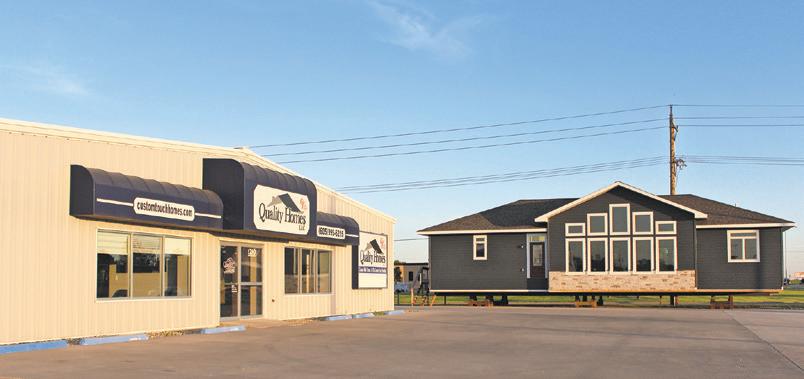Home Garden Spring & inside
THE BENEFITS OF PLANTING NATIVE SPECIES
THE BASICS OF FERTILIZING
A LAWN
POPULAR TRENDS IN NOTICEABLE HOME EXTERIORS





















THE BENEFITS OF PLANTING NATIVE SPECIES
THE BASICS OF FERTILIZING
A LAWN
POPULAR TRENDS IN NOTICEABLE HOME EXTERIORS











































Certain homes have an undeniable wow factor. That instant appeal tends to be noticeable the moment visitors pull up to the curb, and it might be a byproduct of homeowners’ willingness to embrace the latest exterior design trends.
Trends come and go, but recognition of the current fashions can help homeowners create that highly sought-after wow factor. The following are some recent trends in home exteriors that have helped homeowners set their properties apart.

Wood

Natural wood has undeniable appeal, and it hasn’t only found newfound devotion among home interior decorators. Natural wood garage doors create a sense of warmth and can set a home apart from others with steel doors, which tend to be the most popular garage door material. In addition to the garage door, natural wood entry doors and wood decks are popular ways to impart this classical, warm look to a home’s exterior.

Like natural wood, brick is a traditional material that’s both sturdy and classical. But homeowners can add character to brick with a coat of paint, which has become a popular trend in recent years. Light tones tend to be most popular when painting bricks.
tend to be most popular when painting bricks. The experts at Better Homes & Gardens note that this could prove a long-term commitment if homeowners so desire, as a properly painted brick exterior could last as long as 20 years.







Hardscaping

Hardscaping isn’t a new trend, but it has been trending in recent years. Hardscaping is an umbrella term that includes everything from outdoor living rooms to incorporating natural stone into a landscape. Outdoor living rooms are one hardscaping trend that has become increasingly popular of late. These spaces serve as an extension of indoor living spaces. The home improvement experts at HGTV note that recently homeowners have looked to create covered outdoor rooms that can be enjoyed more frequently than patios or decks that are not protected from the elements.
Outdoor lighting

It makes sense that individuals looking to spend more time enjoying their properties outdoors would want more lighting outside. Ambient outdoor lighting can be utilized throughout a property. Such lighting can light up walkways and driveways and be used to light up landscaping features like trees and gardens. Home design trends tend to be fickle. But recognition of the current trends in exterior home design can set homes apart and turn properties into awe-inspiring places to enjoy the great outdoors.










Spring marks the return of lawn and garden season. Lawns often bear the brunt of winter’s wrath, so spring is a great time to nurse them back to health, and fertilizing can be an essential component of that process.

Fertilizing a lawn can be intimidating. An array of fertilizers, with each seemingly designed to address a different issue, can make homeowners’ heads spin when visiting their local lawn and garden center. However, fertilizing is a


very simple task that any homeowner can tackle. In fact, fears about fertilizing are often unfounded and can be overcome with some basic knowledge of the process.

► Identify which type of grass is in the yard. The home improvement experts at HGTV note that turfgrass is divided into two categories: cool-season grass and warm-season grass. A local lawn and garden center can help homeowners identify which type of grass is in the yard, and this often depends on location.

Fescue, bluegrass and perennial ryegrass are some examples of cool-season grasses, while Bermuda, bahia, St. Augustine, and zoysia are considered warm-season grasses. Identifying which type of grass is in the lawn is important because that will indicate when to fertilize. Cool-season grasses are typically best fertilized in early spring, while warmseason lawns can benefit from an application just before especially warm temperatures arrive.
► Survey the lawn to identify which spreader to use. A small yard or a thriving lawn with only a few bald or unsightly patches may not need a full application of fertilizer. In such instances, a hand spreader can suffice. For larger lawns and areas, a broadcast spreader is the ideal
option. Spreaders have multiple settings, and the fertilizer package will indicate which setting to utilize when using the product.
► Test the soil prior to purchasing fertilizer. The lawn experts at Pennington¨ note that a simple soil test can reveal soil pH and phosphorous and potassium levels. Soil tests can be purchased at most home improvement stores and lawn and garden centers, and they can help homeowners determine which fertilizer will most benefit their lawns.
► Water the lawn prior to fertilizing. The experts at Scotts recommend a good watering a few days prior to fertilizing a lawn. Such an approach
ensures the soil is ready to accept the fertilizer once it’s applied.


► Follow the instructions carefully. Detailed instructions are typically provided onfertilizer product packaging. Once homeowners have identified and purchased the product they need, they can simply follow the instructions on the packaging, including how and when to water after application, which can make fertilizing less intimidating.
Fertilizing in spring can help a lawn recover from the previous summer and winter, ensuring it’s lush and green when summer entertaining season arrives.





Spring and summer present ideal growing conditions for many plants, making these seasons an ideal time to tend to lawns and gardens. Though it’s easy to succumb to the temptation of exotic plants, avid gardeners and eco-conscious planters recognize the significance of native plants.


Novices may not realize that native plants are much better for a landscape and the local ecosystem it calls home. Recognition of the many benefits of native plants can make for healthier lawns and gardens and a healthier planet as well.
► Native plants are built for local climates. One of the issues gardeners who plant exotic plants run into is keeping those plants thriving when weather turns harsh. For example, exotic plants may require extra watering in areas that experience drought or even long periods without precipitation in spring and notably summer. The United States Environmental Protection Agency reports that at least 40 states anticipate water shortages by 2024. Planting native plants can help to combat those shortages by reducing the need to water plants if conditions become dry in late spring and summer.
► Native plants save money. It’s also important to note that native plants save homeowners money. Because they’re capable of thriving in local conditions, native plants tend to require less watering, which can help homeowners reduce their utility costs. But native plants also require less upkeep, which means homeowners can save on potentially costly, not to mention eco-unfriendly, pesticides and other amendments in order to maintain the look of exotic plants. And though it’s not always the case, exotic plants tend to cost more at nurseries than natives.

► Native plants save gardeners time. In addition to saving money, native plants don’t require as much attention. Though spring and summer is a great time to be in the yard, it’s also a great time to be out and about. Because native plants thrive in local conditions, gardeners won’t need to spend much of their free time tending to them. Exotics tend to require a lot of extra attention and effort, especially when conditions become harsh. Spending more time outdoors in harsh weather does not appeal to most gardeners.

► Native plants blend in with an existing landscape. Native plants look natural within an existing landscape, adding some instant aesthetic appeal without breaking the bank. When planting exotics, homeowners may feel a need to redesign their entire gardens to create a certain look (think Japanese garden). That can quickly consume a budget and take up a lot of free time in both the short- and long-term.

Planting season marks a great time to revitalize a landscape. Choosing native plants when doing so pays numerous dividends for homeowners and the planet they call home.






Spring is a season of rejuvenation, and perhaps nowhere is that rebirth more noticeable than in the yard. Each spring, grass begins to grow again as inviting landscapes beckon people outdoors. Extra sunlight and rising temperatures make spring a great time to plant flowers, grasses and trees. To ensure successful planting, homeowners must take steps to prepare the soil. Healthy soil can provide the ideal conditions for roots to take hold, helping plants establish themselves before potentially harsh summer conditions arrive. Preparing soil might seem like an extensive job, but a simple approach may be all that’s necessary to create conditions that promote plant growth this spring.
► Clean up the previous months’ mess. Whether homeowners live in regions marked by year-round warmth or places where winter typically features heavy snowfall, it’s a good idea to clean up an area prior to spring planting. Fallen leaves, rocks, grass clippings, and other debris can contribute to compacted soil that makes it hard for plants to establish strong, healthy root systems. Clear away any debris prior to planting before taking the next step in your soil preparation routine.

► Loosen the soil. Once debris has been cleared away, loosen the soil. Depending on the size of the area where you’ll be planting, you may need to invest in tools like a shovel, spade, spading fork, and/or


a lawn edger. If you’re planting in a small area, such as a deck planter box that still has soil from last year’s planting inside it, you can either clean the box and replace the soil entirely or dig around with a handheld trowel, cultivator and/ or weeder. It’s important to loosen all of the soil around where you will ultimately plant prior to planting to

ensure water can reach the roots and help them establish themselves once planting is completed.
► Test and, if necessary, amend the soil. A simple pH test can help determine the acidity or alkalinity of the soil. This is an important step as soil that is too acidic or alkaline can decrease the availability of nutrients
the plants will need to thrive. In addition to conducting a pH test, which can be purchased at little cost at a local home improvement store, homeowners can contact their local Cooperative Extension Service to test their soil quality. These tests will reveal soil pH, but also can shed light on the texture of the soil and other components. Once the test is
conducted, the local Coop Extension Service may recommend amendments to improve the nutritional quality of the soil so new plants can thrive.
Soil conditions go a long way toward determining if new plants will thrive. Preparing the soil prior to spring planting can ensure a successful season.







Summer is a season of relaxation when school is not in session, vacation season is in full swing and people everywhere are getting outside and soaking up the summer sun. It’s hard to imagine how that can get any better. But it can for people thinking of installing a pool in their backyard.
Pools definitely have a wow factor that’s hard to replicate. Homeowners considering pool installation can take note of these factors as they try to decide if a pool is right for them.


The cost to install a pool depends on a host of factors, including which type of pool homeowners are considering and where they live. According to the online home improvement resource Angi (formerly Angie’s list), the average cost to install an above ground pool in the United States in 2022 was $3,322, while the average inground pool installation in the same year was $55,000. That’s quite a disparity in price, and homeowners should know that the average cost of each project is higher in certain regions and under certain circumstances.


Potential ancillary costs, such as excavation and plumbing relocation, will add to the final cost of the project. The erection of fencing around the pool if no fencing currently surrounds the area where the pool will be located also will add to the final cost.


As noted, above ground pools, on average, require a considerably smaller financial investment than inground pools. This is an important consideration, but which option may ultimately prove the better investment is worth researching. Homeowners can speak with a local real estate professional to determine if an inground pool or above ground might yield a significantly higher return at resale. If an inground pool is likely to increase property value by a substantial amount, it could be well worth the extra upfront costs.


Pools are undeniably fun, but they still require maintenance. The experts at Better Homes & Gardens note that vinyl liners in pools last approximately six to 10 years, while painted concrete may require a fresh coat of paint every five years. Plaster finishes may last as long as 15 years, while cementcoated products can last a lifetime. Pools also need periodic cleaning, and
chemicals to keep the pool operating safely and cleanly will require an additional, if somewhat minimal, financial investment. Homeowners investing in a new pool should be aware of the maintenance required to keep the pool clean and be willing to do that maintenance. And though homeowners typically can open and close pools on their own, it’s also possible to hire someone to do it for a relatively small fee each season.









A survey of the land in a yard can reveal how smoothly a pool installation may or may not go. Though it’s possible to install a pool in just about any yard, some spaces might require greater preparation and pre-installation effort than others. Sloped backyards, for example, may require the services of a landscape architect to prepare the space, which can extend the time it takes to complete the project and add the overall cost.

These are just some of the factors that merit consideration when mulling a pool installation. A homeowners’ best resource might be a local pool company who can visit a home, provide an estimate and point out any challenges that may arise during the install.









Few things in nature are as breathtaking as a beautiful landscape. That beauty is perhaps one reason why many homeowners spend so much time and expend so much effort on their lawns and gardens.
Though plenty of homeowners love spending time in the yard, others may not be so inclined. For the latter group, low-maintenance trees can be just what the doctor ordered. Lowmaintenance trees can provide the beauty nature-loving homeowners desire without all the extra work of more needy plants. It’s always best to consult a local landscaping professional prior to planting to ensure a tree will thrive in a given climate. In preparation for that consultation, homeowners can study this list of three low-maintenance trees while recognizing that all trees may need a little extra TLC in extreme weather.
Instantly identifiable by its purple blooms, the jacaranda tree is native to South America, which makes it ideal in warm climates. The jacaranda tree is considered a shade tree and if or when it sheds it leaves, those leaves can typically be mowed, saving homeowners the work of raking them. However, the online home and garden resource The Spruce notes that jacaranda trees can require substantial maintenance when planted near surfaces where people walk, such as driveways and patios. So when planting jacaranda trees, it’s ideal to do so in locations where falling leaves will land exclusively on grass.

2. American arborvitae: The Arbor Day Foundation¨ notes that the American arborvitae requires almost no care when it’s used as a hedge or a screen. That’s a popular use for this versatile specimen with a narrow, pyramid shape. Though it does not provide the bright blast of color offered by the jacaranda, the American arborvitae creates an elegant look that offers considerable privacy as well.

3. Japanese red maple: The Home Depot notes that the Japanese red maple are very low-maintenance trees that can adapt to various soil types and grow in an assortment of light conditions. During dry periods, however, the ADF notes the importance of keeping soil consistently moist. Various types of soil can accommodate the Japanese red maple, so this is a consideration for any homeowner looking to add some color to their lawns without a lot of extra work.

When considering new trees for a property, homeowners can easily be persuaded by the beauty of the tree. Though that’s worthy of consideration, homeowners who want lowmaintenance trees should speak to a gardening professional about the work required to maintain a tree’s beauty throughout the year, especially during periods of drought or other adverse conditions. In addition, ask the gardening pro to recommend non-invasive trees. Planting invasive trees can be harmful and cause damage to surrounding plants, which can be costly and timeconsuming to address.









or you can line it up yourself.

